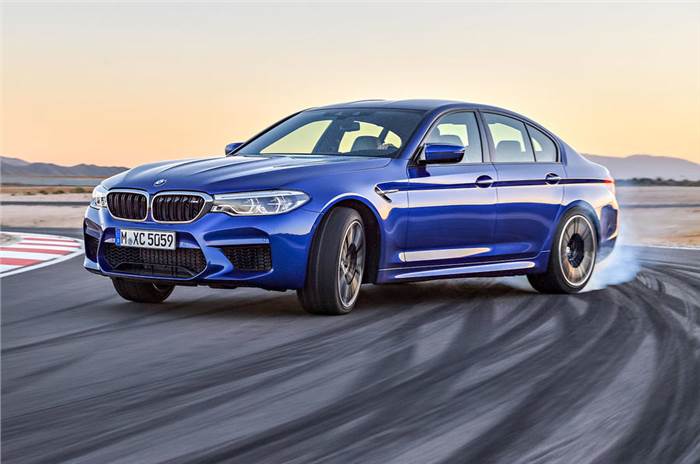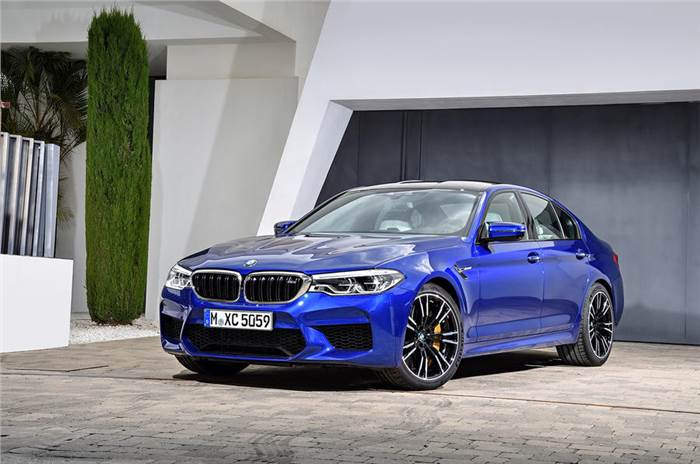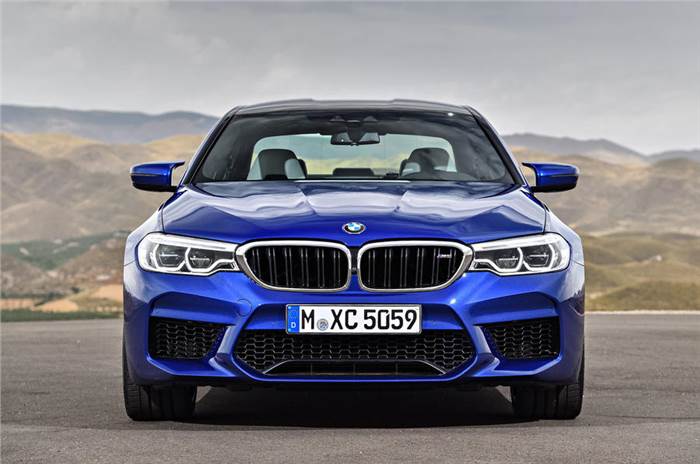After being teased for the past couple of months, BMW has revealed its all-new M5. Unlike its predecessors, the new M5 adopts the xDrive, all-wheel-drive system that’s available on all BMW SUVs.
The performance luxury sedan is powered by a heavily reworked 4.4-litre turbocharged V8 motor tuned to churn out 600hp. Along with the all-wheel drive system the engine helps the M5 reach 100kph in a claimed 3.4 seconds and go on to top out at 304kph.
The new M5 is based on the latest 5 Series and shares the CLAR (cluster architecture) underpinnings. This has helped to make the car more rigid, yet lighter, when compared to its predecessor. BMW’s M division claims it contributes to even more engaging driving traits than the outgoing F10- generation model, despite the adoption of all-wheel drive in place of the M5’s traditional rear-wheel drive.
M division boss Frank van Meel said: “Thanks to M xDrive, the new BMW M5 offers true rear-wheel-drive-like driving traits as well as significantly enhanced directional stability and controllability right up to the limits of performance, even when driving in adverse conditions such as in the wet or snow.”
Revealed as part of Electronic Art’s Need For Speed: Payback, a video game in which it stars, the new M5 is visually differentiated from standard 5 Series models by a range of customary BMW M division styling cues. These give it a muscular and familiar appearance.
Dimensionally, BMW’s new performance saloon is bigger than any other M5 before it Length grows by 55mm to 4965mm, width is up by 12mm to 1903mm and height has increased by 16mm to 1473mm.
Despite these increases and the adoption of all-wheel drive, kerb weight is down by 25kg over the fifth-generation model, at 1855kg. Weight-saving initiatives employed on the new M5 include an aluminium bonnet, carbonfibre roof, a boot-mounted lithium ion battery and a lightweight exhaust system.
One of the keys to the M5’s enduring success through the years has been its practical four-door layout and comparatively roomy interior. The new model continues this by offering seating for up to five people and a nominal 530 litres of luggage capacity. Inside, there is a new multi-function steering wheel, M-specific digital instruments and electrically adjustable seats.
Mounted longitudinally up front, the engine used by the new M5 is a development of its forebear’s twin-turbo 4.4-litre V8. The direct-injection petrol unit receives new turbos, a revised intercooler, increased fuel-injection pressure of 350 bar and a new high-capacity oil pump.
Power is increased by 40hp over the standard version of the previous M5, at 600hp, and it is delivered some 400rpm lower than before at 5600rpm. This gives the new model a power-to-weight ratio of 323hp per tonne, which is 24hp per tonne more than its predecessor. Torque is also up, by 69Nm. A stout 750Nm is developed over a wide, 3800rpm range between 1800rpm and 5600rpm. Additionally, the driver can choose between three modes — Efficient, Sport and Sport Plus — via a Drive Performance button.
The increased engine performance allows the new M5 to match the output of the 30th anniversary M5 launched in 2014, albeit with an added 50Nm. To put this into perspective, the Mercedes-AMG E 63 S 4Matic’s twin-turbo 4.0-litre V8 powerplant kicks out 611hp and the same 750Nm, and the Audi RS6 Plus’s twin-turbo 4.0-litre V8 engine delivers 605hp and 700Nm.
Although BMW is talking up the fuel economy of the M5’s revised engine, its combined cycle average of 9.52kpl and CO2 rating of 241g/km fail to better the claimed 10.1kpl and 232g/km of the old model.
The intensity of the exhaust note is controlled by a flap within the exhaust system and influenced by the different driving modes. An M Sound Control button allows the driver to reduce noise levels when desired.
All the power is channelled through a new eight-speed torque-converter automatic gearbox with remote steering-wheel-mounted shift paddles. A so-called Drivelogic software package provides it with three different driving modes as well as a full-manual mode for sequential shifting via a rocker switch located on the centre console. The ZF-engineered unit, which is combined with a 3.15:1 final drive ratio, replaces the Getrag-produced seven-speed dual-clutch unit used by the fifth-generation M5.
An even more significant departure for the M5, though, is the adoption of all-wheel drive — a first for the M5. Dubbed M xDrive, the hardware of the four-wheel-drive system is based around that used in standard 5 Series xDrive models and BMW M’s existing Active M differential. However, a sophisticated software system with proprietary code developed in-house by BMW M is claimed to ensure drive is sent to the front wheels only when the rear wheels are unable to transmit any more power to the road and additional traction is required.
The inclusion of M xDrive has allowed BMW M to offer a variety of different driving modes, the most aggressive of which, M Dynamic, permits pure rear-wheel drive in a process designed for track use.
BMW M’s decision to eschew traditional rear-wheel drive for the new M5 comes just over a year after Mercedes-AMG announced that the E63 would be offered exclusively with its own 4Matic all-wheel drive set-up. It also brings the M5 into line with the RS6, which has featured quattro four-wheel drive since its inception in 2002.
The added traction from the four-wheel-drive system helps the new M5’s official 0-100kph time, which betters that of its rear-wheel-drive predecessor by a full 1.0sec, at just 3.4 seconds. This is the same time quoted by Mercedes-AMG for the E63 S 4Matic and beats the RS6 by 0.5 seconds. BMW M also claims a 0-200kph time of 11.1 seconds.
The nominal top speed of the new M5 is pegged at 250kph, although customers can have that raised to 304kph by specifying an option called the Driver’s Package.
The increase in straight-line performance helps to distance the new M5 from the recently introduced M550i xDrive, whose 462hp version of BMW’s turbocharged 4.4-litre V8 engine propels it to 100kph from rest in 4.0 seconds and to a top speed of 250kph.
Underpinning BMW M’s latest model is a heavily modified version of the standard 5 Series’ double-wishbone front and five-link rear suspension, featuring bespoke components described as being “unique to the M5”. Among the larger changes are the additional brace and the aluminium transverse struts at the rear to increase the stiffness of the suspension linkages. New wheel location has increased the wheelbase by 7mm over the M550i xDrive’s, at 2982mm, making it 18mm longer than the fifth-generation M5’s. Meanwhile, the front track has been increased by 26mm, at 1626mm, and the rear track is reduced by 2mm to 1595mm.
The tuning of the M5’s suspension has taken place predominantly at BMW’s Miramas test track in France and the Nürburgring in Germany. The new M5 will feature standard-fit 19in wheels shod with 275/40 front and 285/40 rear tyres or optional 20in rims with 275/35 front and 285/35 rear rubber.
The new M5 will go on sale in the UK in February next year, following its public unveiling at the Gamescom video game show in Cologne, Germany, this week. There is no word on whether it will arrive in India.





























Comments
Member Login
Personal Details
No comments yet. Be the first to comment.